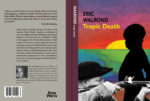The publisher says:
Tropic Death is a collection of short stories from the Caribbean and Central America, with themes of colonialism, race, and class. The book was first published in 1926 by Eric Walrond, and it became a popular book associated with the Harlem Renaissance. This is a new edition of the original publication.
Nathan says: Sorry, but I don’t think this works. At all. The three main image elements don’t mesh with each other stylistically or spatially, and worse, I don’t come away with any inkling of what the book is about or why I should read it.
I find that covers for new editions of “significant” literature from the past works best using one of two starting points:
- A photo of the author.
- An image sourced from the time period of first publication.
Any other comments?


This doesn’t work well at all, especially with the mish-mash of styles. And that clip art of what appears to be a naked ethnic child, overlaid by an adult in b/w, comes off as exploitive and callously uncaring.
On Amazon there is a re-release, I’m not sure how old, that takes a simple approach of three horizontal bands of blue water interspersed by off white bands, and a small island in the middle. The overall effect gives it a vintage literature vibe, and it’s clean/coherent, not busy. While it’s not the most modern cover, neither is yours, and I would pick up that one to look at while you’re would just confuse me.
You do have a photo of the author on the back cover – why not repurpose that for the front? Or find some vintage art or photos from the era, as Nathan suggested?
Go back to the drawing board to look for a unified concept, don’t just throw anything on the cover collage style.
For some ideas, you could look at various re-releases of “Heart of Darkness” on Amazon. It’s a slightly older book, but it’s also classic lit with a tropical setting. Notice every re-release has a single image, or no images and just a stylized set of colors like a black dot on red, or a tan band on the top third over a field of green. Images are things like a b/w shot of two people boating along an island, a tribal mask, a blue tinted old painting of men in a boat,a stylized palm leaf print over dark blue, a map, or a tree in front of the moon or sun. But none of them “mash” different styles of color schemes.
I agree with Nathan and Jennifer: the cover is all over the place. It is also, I think, misleading in not really conveying any real sense of what the book is about. I certainly don’t think that anyone seeing the cover and not already knowing something about the book would have any idea what its subject or themes would be.
Any of the book’s earlier incarnations had far better covers and it might be worth taking a close look at them.
https://justseeds.org/wp-content/uploads/Walrod_TropicDeath_Collier.jpg
https://d3525k1ryd2155.cloudfront.net/h/788/734/288734788.0.l.jpg
https://images-na.ssl-images-amazon.com/images/I/51Rf1yuW6QL.jpg
The suggestion that you look for period imagery is a very good one. The Library of Congress has a huge collection of historic images, almost all of which are free for use. For instance, a search for “Central America” resulted in over 4000 high-resolution images of vintage photos and artwork https://www.loc.gov/pictures/search/?q=central+america&fa=displayed%3Aanywhere&sp=1&st=gallery
I feel that it’s also very deliberately provocative, as if it’s about a white man shooting an ethnic child. I mean…you can’t not see it. That does feel, as Jennifer said, very exploitative.
I just think that as his work is considered literature, it needs a cover that’s more appropriate and typical, for Lit, and less like genre fiction.
That’s my $.02. The font use is really not good, either.
In thumbnail, this is a very pretty and—alas—rather meaningless cover. Up close, I’m seeing the child and guy with the gun a bit more clearly, but the only meaning I could draw from it before I read the summary is “That guy is either about to blow that kid with the distended belly (for some reason; what a sicko!) as soon as he’s done hunting, or he’s about to blow somebody away while the kid watches (which is also pretty sick and disgusting when you think about it).” I get that you’re trying to be a bit disturbing, but I don’t think “guy who’s about to traumatize some starving little black boy by either molesting him or murdering somebody in front of him” is going to be very appealing to your target audience. When dealing with such grave and ponderous topics as “the crimes of tropical colonialism” on your cover, you have to walk a fine line between being appropriately disturbing and nonetheless still being visually appealing.
If I were doing this cover, I’d probably use the same beautiful “tropical landscape” color scheme you’ve got here, but overlaid on just one object known to symbolize something disturbing, e.g. a noose hanging from the gallows. Such a mixture of things that don’t typically mix (beautiful colors on something typically used for exceedingly ugly purposes) provides the kind of mood whiplash that gets your prospective readers’ attention without disgusting and discouraging them: “So, this is a book about the beautiful tropics… and all the heartbreak and misery that happened amid all that beauty.”
I think that perhaps the problems with the cover stem from an overfamiliarity with the book: the person creating the cover knew what the book was about…but to someone seeing it cold, who may not recognize the title or author, they have nothing to go by but what they see. And what they see is a very misleading image.
Try to step back and look at the cover as though you were seeing the book for the first time, as though you have never before heard of the book or its author.